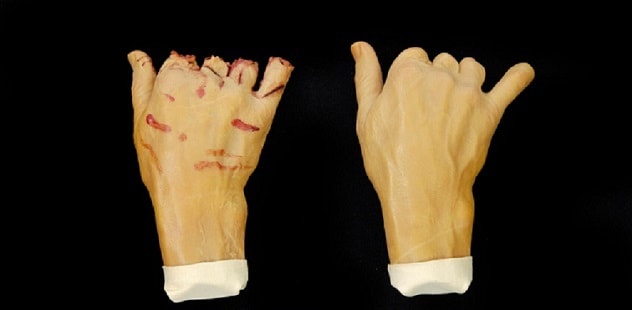Oct. 03, 2023
This Q&A features David G. Dennison, M.D., a hand surgeon who has worked at Mayo Clinic in Rochester, Minnesota, for 20 years and now has moved to practice at Mayo Clinic Health System in Eau Claire, Wisconsin.
Here, Dr. Dennison talks about hand injuries occurring on farms, a common scenario in Minnesota, Wisconsin and Iowa.
Are farm-related hand injuries seasonal?
Yes, they seem seasonal. Usually, we see that hand injuries occur on farms during harvest more often than planting time. Hand injuries appear to be more common later during harvest season. Weather and moisture can delay harvest and lead to a shorter window to complete all necessary tasks. This tight schedule to harvest along with diminishing light in the afternoon and evening might be factors associated with risk of injury.
What types of farm-related hand injuries do you see?
 Dedos lesionados
Dedos lesionados
Dedos atrapados en una trituradora de maíz
My Mayo Clinic hand surgeon colleagues and I have seen severe injuries in Southeast Minnesota, such as a corn picker destroying both of a patient's hands or farm equipment causing bilateral amputations. The most severe injuries can be life-threatening.
In general, we see farm-related hand injuries from not only corn pickers but also from augers, tractor hitches and even falls around silos. ATVs used on a farm also can pose a problem, especially as riders' arms end up outside the vehicle often. Any equipment with a power takeoff — a spinning shaft connecting an engine with machinery — can cause injuries if it catches on clothing and then ensnares and injures a limb.
We also see burns to the hand, or lacerations or cuts occurring in the naturally dirty farm environment. We have seen injuries from patients who've been kicked by livestock or injected themselves accidently during animal vaccination, and even wrist injuries that occurred during artificial insemination. I remember another patient who had an injury from a bolt used for euthanizing pigs. It caused a severe and contaminated open fracture in his hand.
We see some animal bites; cat bites are common. Occasionally, we see poke or stab injuries to the hand that occurred while fencing. Cat bites demand immediate care and antibiotics, at the very least.
Are there common demographics for individuals who injure their hands on a farm?
Yes, we often see male patients with an age range of roughly 35 to 70.
If a patient arrives with a hand injury from a farm, do you have any patient care tips?
We will evaluate the patient with a standard trauma survey and then look more specifically at the isolated limb injury:
- Perform a trauma assessment based on ATLS guidelines utilizing a systematic approach: ABCDE.
- If the patient is bleeding, start with compression and elevation of the injured arm and hand.
- Conduct a thorough patient examination, looking for other injuries and signs of shock. Identify wounds, any deficit in function, and fractures or suspected fractures. Obtain X-rays of suspected fractures.
- Provide basic wound care: Remove any gross contamination; irrigate and cover the wound.
- Reduce any deformity. Apply a splint or dressing.
- Start antibiotics and administer tetanus and diphtheria vaccine.
With this kind of hand injury, is there anything you'd advise not to do?
Use tourniquets as needed but be certain to use them carefully. I've seen problems from tourniquets used inappropriately. It's important to be well-versed in tourniquet use. Elevation and compression are often enough to manage the bleeding associated with hand and wrist injuries.
What do you suggest if a farm incident severs part of the hand?
Wrap the severed part in saline-moistened gauze and then place it in a plastic bag. Keep the plastic bag on ice. Time is a limiting factor for replantation, so referral should be urgent in nature. The time limit for digit replantation may range from 6 to 12 hours, depending upon the care of the part. However, any hand or forearm amputation has less than a six-hour window due to the muscle in the hand and forearm, compared with fingers that do not have muscle.
What is the likelihood of replantation of a severed hand or finger?
That depends on the mechanism of injury. If a sharp cut causes the amputation of a digit or hand, replantation is more likely to be successful. If an avulsion has occurred, replantation is less likely due to the more significant injury to the blood vessels and tissue. For example, if spinning equipment pulls a finger off the hand, there is less chance of replantation. Other risk factors for a failed replantation include diabetes, older age and smoking. As opposed to adults, kids have a better chance of healing from one of these injuries.
If those of us working in trauma centers in the region need to consult with a hand expert for a farm-related hand injury, is there someone we can contact?
You are welcome to call Mayo Clinic and speak to the Admission and Transfer Center. Staff there will connect you with the hand surgery team anytime for consultation.
If a trauma professional in the region thinks a patient needs a transfer to Rochester for a hand injury, will you accept the patient?
Yes. We will do our best to accept every patient we can help. We can facilitate a transfer through the Admission and Transfer Center.
For more information
Refer a patient to Mayo Clinic.